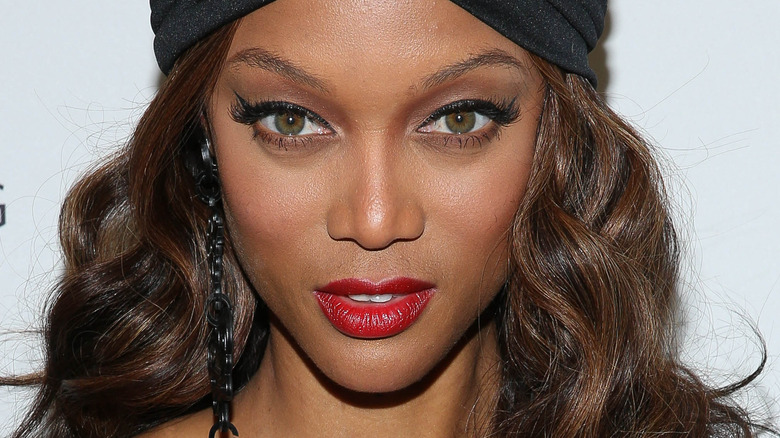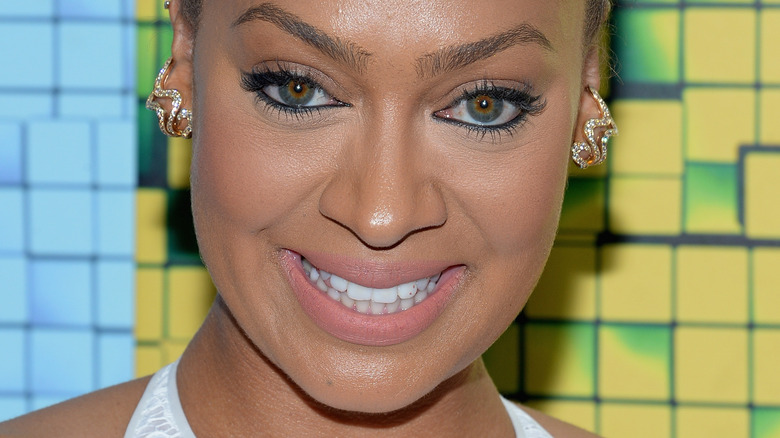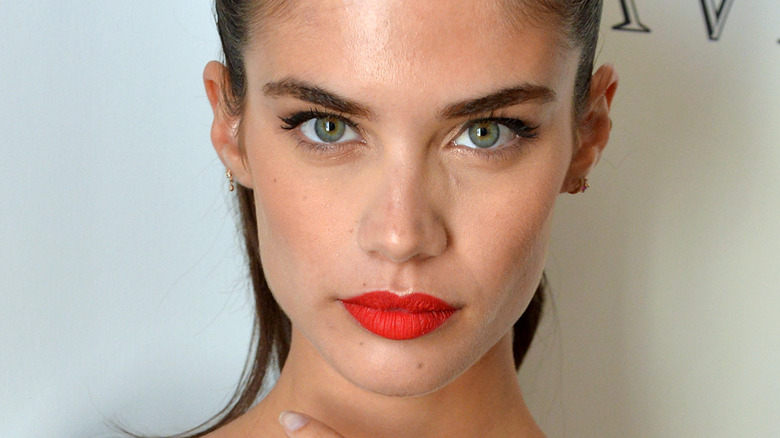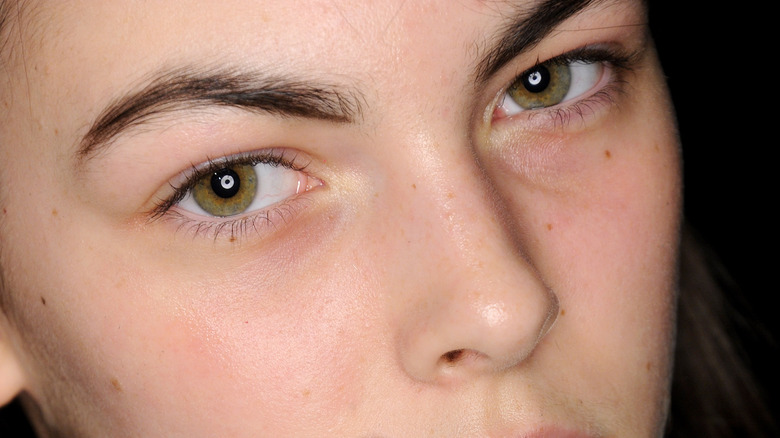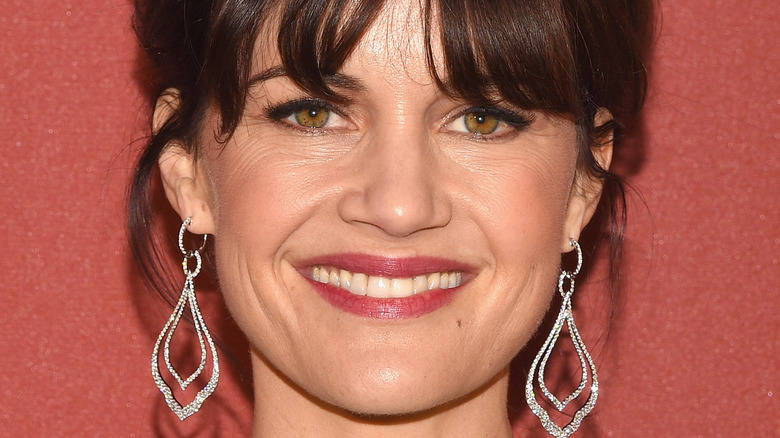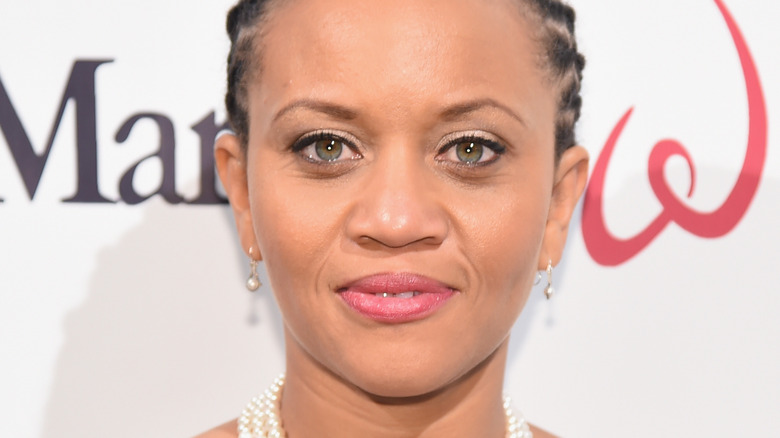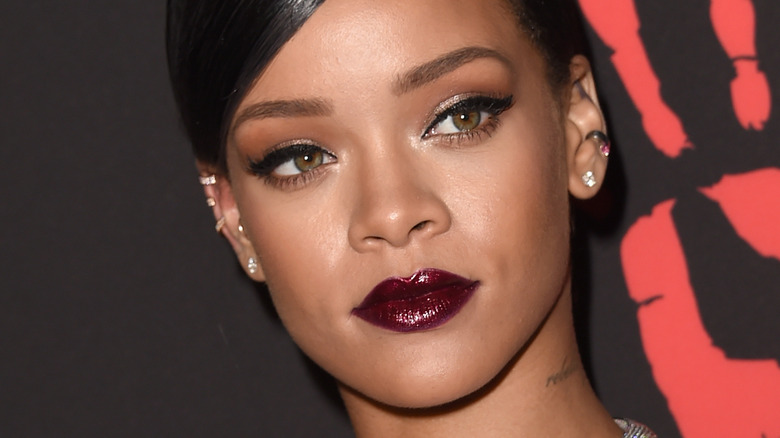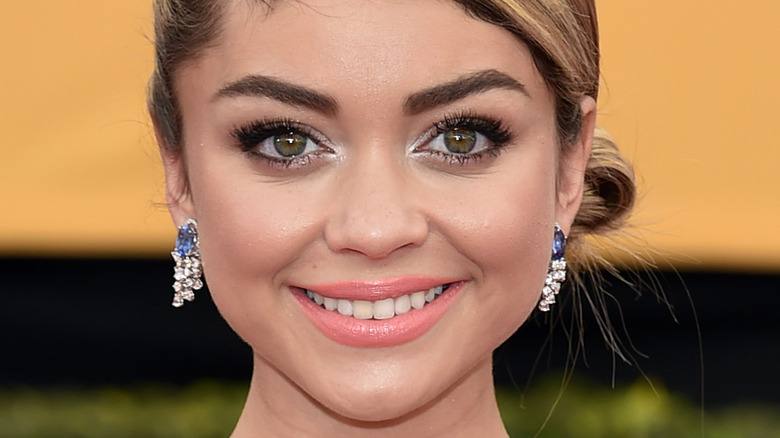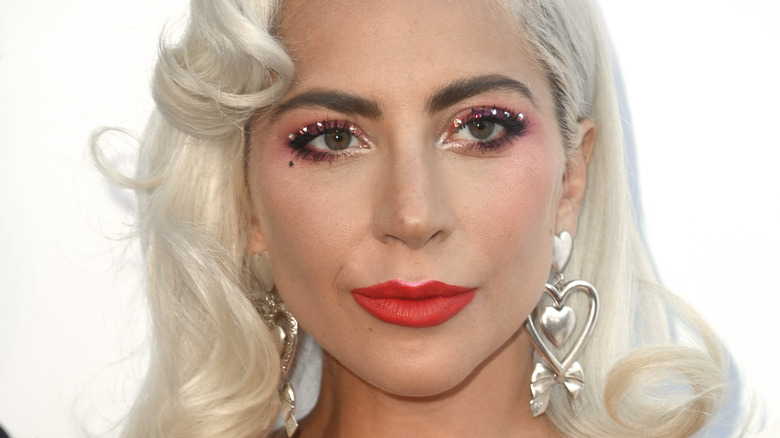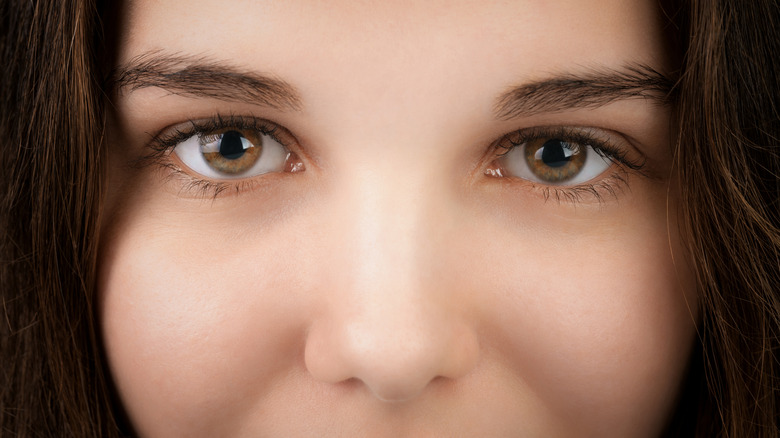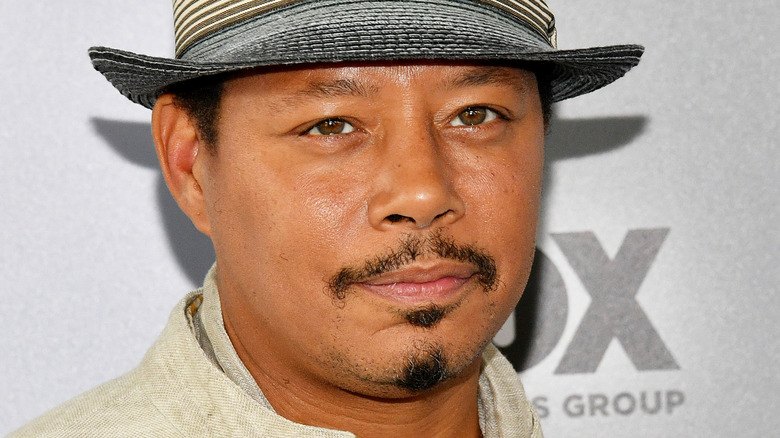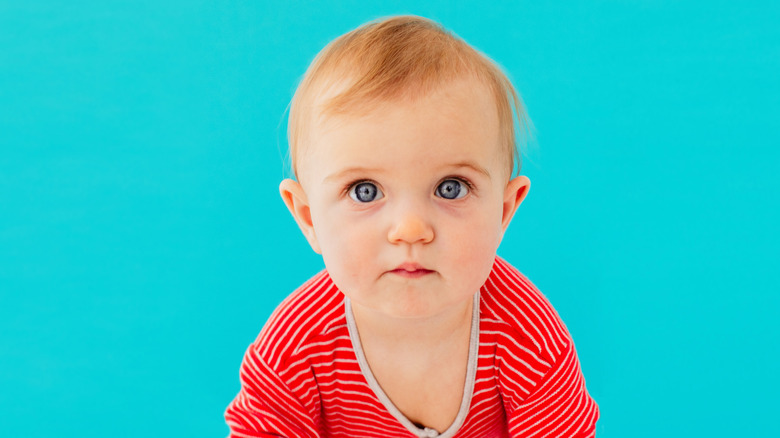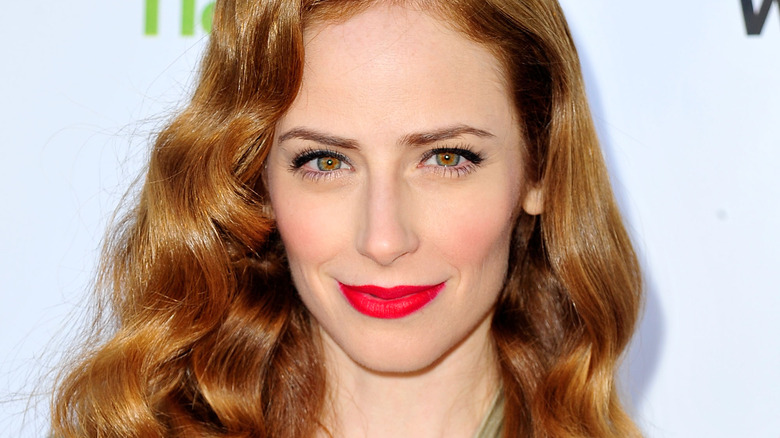The Truth About Hazel Eyes
Hazel eyes, arguably one of the most mysterious eye colors, are as unique as they are beautiful. And while hazel isn't exactly a color, per se — it's more of a pattern of colors within the iris — those lucky enough to be blessed with this phenotype can have a mix of brown, yellow, green, and blue in their irises. That's why no two pairs of hazel eyes are exactly alike and why each pair has their own nuance.
When it comes to celebs who are known for their hazel eyes, model Tyra Banks immediately pops to mind, with her piercing brown and green gaze. Or perhaps you think of actresses like Demi Moore, Shailene Woodley, and Jada Pinkett Smith, who all have equally arresting peepers. And, of course, there's singer Rihanna's dramatic hazel stare, which somehow manages to look a little bit different in every picture.
So what's the science behind this one-of-a-kind eye color? Is having hazel eyes common or is it more of a genetic rarity? And why is it that hazel eyes seem to change color or look different depending on a person's surroundings? Read on to learn the truth about hazel eyes.
What color are hazel eyes exactly?
Whereas people with brown, blue, and green eyes usually only appear to have one color in their iris, people with hazel eyes have several, according to an article in Owlcation. Additionally, as previously stated, having hazel eyes is less about color and more about how color is distributed within the iris. And that can have some significant variation, as there's a lot at play when it comes to how hazel eyes appear.
Specifically, the hazel pattern begins with a ring of color around the pupil, usually brown. Then, as you move away from the pupil and out toward the rest of the eye, the color will shift into green, sometimes with an additional ring of amber in between. This burst-like pattern is what makes hazel eyes distinct from green eyes, which don't have the same kind of color shift and are monochrome in appearance. As noted by Owlcation, hazel eyes "may have a yellowish brown, dark brown or amber-brown surrounding the pupil."
That's not to say that people with different eye colors can't have variation in their irises, as they certainly can. But this unique variation is how it works for our hazel-eyed brethren.
Hazel eyes are all about the melanin
Interestingly enough, as diverse as hazel eyes appear, there's actually only one color in the irises of people with hazel eyes and that's brown, according to All About Vision. That brown color comes from a pigment that's called melanin, which is responsible for how dark or light a person's skin is as well. The more melanin you have in your iris and your skin, the darker both will appear. That explains a lot.
Okay, but if there's only one color in a hazel iris, why do we see green, yellow, and sometimes even a hint of blue? You can chalk that up to the Tyndall effect, which is similar to the mechanism that makes both the ocean and the sky look blue. Essentially, the way that light is scattered combined with the amount and placement of melanin determines how hazel eyes appear. So where there's brown, there's a lot of melanin. Where there's yellow and green, there's less melanin and light being scattered in combination. And if there's blue, there's no pigment at all, at least not in the front layers of the iris. Fascinating, no?
Hazel eyes are not very common
In addition to actors and models like Tyra Banks and Shailene Woodley, there are plenty of other celebs with hazel eyes out there. From Shad Moss (aka Lil' Bow Wow) to Heidi Klum, when you turn on your television, chances are you'll see plenty of hazel-eyed beauties and gents in both shows and commercials. That's not surprising, taking into account how unique and multi-faceted hazel eyes can appear, especially in their more rare expressions.
But chances are that hazel eyes are over-represented in the media, as not many people are lucky enough to have this distinct phenotype. In fact, only five percent of the world's population has hazel peepers, according to an article in World Atlas. That's in comparison to the 79 percent of people on earth who have brown eyes, dwarfing every other eye color with its dominance. And in addition to that, eight to ten percent of the world's population have blue eyes, most of them living in various European countries like Finland, Estonia, Ireland, and Scotland. So hazel-eyed folks, celebrate yourselves! You're a rare bird, indeed.
But hazel eyes are not the least common eye color
Despite the fact that having hazel eyes is not very common, there are several other eye colors that are far more rare, according to an article in World Atlas. Given how complex and complicated genetics can be, that's not exactly a shock, though it certainly is an intriguing factoid.
To start, roughly the same percentage of the world's population have amber eyes — five percent — thanks to lipochrome, a yellow pigment that makes the iris look yellow or coppery. However, this is more common in animals like dogs, fish, and birds than it is in humans. After that, folks with green eyes clock in at two percent, thanks to lipochrome, low melanin levels, and the way light scatters in the eye.
Finally, there are three eye colors that are so rare that less than one percent of the population has them: gray eyes, red/violet eyes (often only in people with a severe form of albinism), and heterochromia (different-colored eyes). Truly those are one in a million.
This is why hazel eyes seem to change color
If you have hazel eyes, or if you've looked at different images of people with hazel eyes, you've probably noticed that often hazel eyes appear to change color. That's certainly the case with Tyra Banks, for example, whose eyes can appear super green in some pictures, while they sometimes look more yellow and brown in others. The same is true for Jada Pinkett Smith, who passed on her riveting hazel peepers to her daughter, Willow Smith.
Of course, science has a reason for that. According to an article in Owlcation, hazel eyes change color based on environmental factors such as the color of objects in a room and the amount and type of light that is filtering into the iris. Additionally, the color shift is also dependent on how much melanin is in the iris. So if a person with hazel eyes with minimal melanin in their eye is wearing a green dress, their eyes will appear greener. And if a hazel-eyed person with a lot of melanin in their eye is wearing a brown dress, their eyes will look more brown. Boom, mystery solved!
Blue-eyed parents can have children with hazel eyes
In elementary school, middle school, or high school, chances are you were taught that eye color is dependent on dominant and recessive genes, and were forced to diagram a bunch of Punnett Squares to prove it. It followed, then, that brown eye color is dominant over all other eye colors, including hazel. So according to that model of genetic determination, blue-eyed parents couldn't have brown-eyed offspring, and brown-eyed parents could only have blue-eyed (or green or hazel) offspring if they both carried the recessive gene for those eye colors.
But as it turns out, that model was way over-simplified in some ways and totally wrong in others. The newer, more current genetic research that's available about how we get eye color shows that there are 16 genes in play that make this determination. That means that eye color isn't determined by a simple recessive or dominant gene; rather, it's reliant upon variations of several genes and how they interact with one another. That's why it's possible for blue-eyed parents to have children with hazel eyes.
Do people with hazel eyes handle pain better than others?
Although having hazel eyes is a beautiful thing, there are some things that come with this phenotype that aren't quite as lovely. For example, brown-eyed and hazel-eyed ladies are more sensitive to pain than lighter-eyed folks. Who knew eye color could be linked to something like that? There's no end to how unpredictable genetics are and how far-reaching the impact of them can be on people.
But they are indeed connected, according to an article published in The Journal of Pain. In the study, which was conducted at the UPMC Magee Women's Hospital, researchers surveyed a total of 58 expectant mothers who were planning to deliver their babies there. They divided the women into two groups, 24 in the group with hazel and brown eyes and 34 in the group with light-colored eyes. The aim was to study postpartum and antepartum pain, sleep, coping behavior, and mood.
The results? As it turns out, women with lighter eyes had an easier time giving birth than their darker-eyed counterparts. Additionally, they were less prone to anxiety and depression — all thanks to having less melanin in their irises. Wild, huh?
How can hazel eyes affect alcohol tolerance?
Just as folks with hazel eyes are more sensitive to pain, they are also more sensitive to alcohol. Though it's a little more complicated than it sounds.
Specifically, people with brown or hazel eyes are more sensitive to alcohol than folks with light eyes, according to an article in the journal Personality and Individual Differences. In the study, researchers looked at two sets of archival data: one group was comprised of 10,860 white men (who happened to be prison inmates), and the other was made up of 1,862 white women who responded to a national survey. What they found was that in both samples, light-eyed folks drank much more alcohol than hazel-eyed and brown-eyed people. The reason? Lighter-eyed individuals are less sensitive to alcohol's affects, which, in turn, made them consume more of it. That also means that hazel-eyed folks are less prone to developing a physical alcohol dependence. Nothing wrong with being a little more efficient!
Blue-eyed men don't prefer women with hazel eyes
To the ladies with hazel eyes out there currently partnered to a blue-eyed man: your relationship beat the odds — at least according to science. Blue-eyed men find blue-eyed women more attractive than they do women with any other eye color, according to a study in the journal Behavioral Ecology and Sociobiology. Blue-eyed men were the outliers too, as blue-eyed women didn't have a preference for their partner's eye color. Neither did brown-eyed and hazel-eyed men and women. Um, what exactly is going on here?
Fortunately, the researchers have a theory about why this is the case, which sheds a little light on this mystery. They believe that blue-eyed men's preference for ladies with the same phenotype is born out of potential paternal uncertainty, which is defined as having doubt of their child's true paternity. In other words, if the azure-eyed man's baby has blue eyes, he will be more convinced that it's biologically his. That's because two blue-eyed parents may be more likely to have a blue-eyed child than not, although the latter is a possibility nonetheless.
Are hazel eyes different from eyes with heterochromia?
Part of the reason that hazel eyes are so unique and beautiful is because they have two or more colors within the iris, which is pretty uncommon. But don't get that confused with another condition wherein the iris has different colors in it, which is called central heterochromia, according to an article in Owlcation. That's when the iris has two different colors, with one color in a ring around the pupil that's different from the rest of the iris. The pattern is similar to that of hazel eyes, but it's not the same thing.
There are other forms of heterochromia as well. For one, there's complete heterochromia, which is when the color in the iris of one eye is completely different than that of the other eye — think Alice Eve. There's also sectoral heterochromia, which is when the iris has splotches that are a different color from the rest, like the eyes of actors Dominic Sherwood and Kate Bosworth.
All forms of heterochromia are much less common than hazel eyes and also happen in the animal kingdom in cats, dogs, and more. Fascinating!
You can be any race and have hazel eyes
Those of the hazel-eyed persuasion don't hail from one specific ethic group or race. Rather, you can be any race or ethnicity and be lucky enough to score a set of hazel peepers, as evidenced by the many celebs who have them.
In addition to those already mentioned, which includes both white and black women, plenty of diverse men have hazel eyes. For one, Empire actor Terrence Howard has a lovely pair of hazel-colored peepers, and he's biracial, as noted by The Grio. Additionally, the super gorgeous model Daje Barbour has an exquisite set of hazel eyes, and he's African American.
As for other folks, Gilmore Girls star Jared Padalecki has some arresting hazel eyes, and he's white. OG badass Danny Trejo also has an especially lovely hazel-green eye color, and he's a proud Latino. South Korean actress Lee Sung Kyung is also in the hazel club, proving that hazel eyes are truly universal.
Blue-eyed babies can become adults with hazel eyes
For some of us, the eye color that we present with at birth is the same that it will be for the rest of our lives, according to an article posted by McGill University. This is especially true for folks of Latinx, Asian, and African decent, as that's where brown eyes are overwhelmingly the norm, so plenty of melanin will be present in the iris at the time of a baby's birth.
But that's not the case for everyone. For white or other less-melanated people, it's not uncommon at all for babies to be born with blue eyes that can later turn different colors, including hazel. That's because it can take a while for melanin to be deposited into the iris, which usually is completed after about six months. At that time, a baby's eyes can turn green, hazel, gray, or brown. And in some cases, it can take much longer for eye color to fully develop, sometimes into adulthood. That's just one more mystery that melanin brings to the genetic table.
Are people with hazel eyes more at risk for cancer than brown-eyed people?
Although having light-colored eyes is considered to be quite beautiful, it can come with its own set of risks and vulnerabilities. To that end, it's important to point out that people with hazel eyes who have more melanin in their eyes are less prone to some risks than hazel-eyed folks with super light-colored eyes. It's just the luck of the draw.
Specifically, if you have light-colored eyes, you're more at risk for some kinds of cancer, according to Every Day Health, which includes light-colored eyes with a hazel pattern. That's because the lighter your eye color, the more light-sensitive your eyes are, so you need to take precautions. "People with light iris color need to be diligent in wearing UV-protected sunglasses," said Dr. Ruth Williams, an ophthalmologist at the Wheaton Eye Clinic in Chicago. "This is likely due to the sparsity of light-absorbing pigment in the eye. The more pigment you have, the less light gets through the iris." So in order to avoid getting melanoma of the uvea, protect your hazel peepers, especially if they're greener than they are brown.
